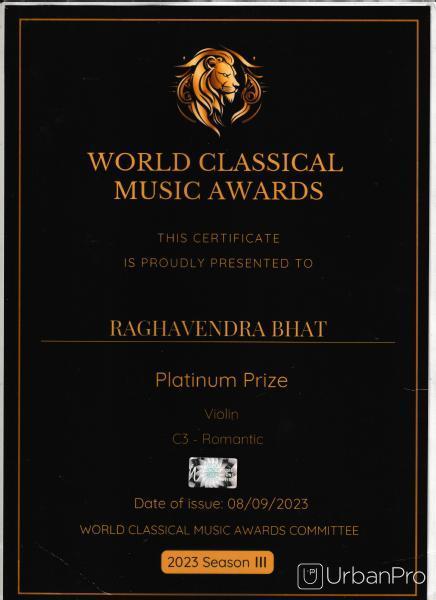
Platinum
Andheri West, Mumbai, India - 400058.
73
Details verified of Raghavendra✕
 Identity
Identity
 Education
Education
Know how UrbanPro verifies Tutor details
Identity is verified based on matching the details uploaded by the Tutor with government databases.

Hindi Proficient
English Proficient
![]() Mumbai University 2022
Mumbai University 2022
Bachelor of Laws (L.L.B.)
 Trinity college Pursuing
Trinity college Pursuing
FTcl
 World Classical Music Awards Committee 2023
World Classical Music Awards Committee 2023
World Classical Music Awards Certificate
Andheri West, Mumbai, India - 400058
![]() ID Verified
ID Verified
![]() Phone Verified
Phone Verified
![]() Email Verified
Email Verified
Report this Profile
Is this listing inaccurate or duplicate? Any other problem?
Please tell us about the problem and we will fix it.
Class Location
![]() Online (video chat via skype, google hangout etc)
Online (video chat via skype, google hangout etc)
![]() Student's Home
Student's Home
![]() Tutor's Home
Tutor's Home
Years of Experience in Violin Classes
10
Age groups catered to
Below 10 yrs, 16 yrs to 25 yrs, Above 25 yrs, 10 yrs to 15 yrs
Genre
Western, Classical
Class strength catered to
One on one/ Private Tutions
Teaching Experience in detail in Violin Classes
I’ve been playing the violin for over a decade now and have spent several years teaching students of all levels. From beginners who are picking up the violin for the very first time to advanced players looking to refine their skills, I enjoy helping every student progress toward their unique goals. For beginners, I often use the Suzuki and Eta Cohen methods because they provide a solid foundation and make learning enjoyable. Along with technical exercises, I like introducing simple yet beautiful pieces early on to keep things fun and rewarding. For intermediate and advanced players, I focus on refining technique, mastering challenging repertoire, and working on musical expression. I’ve also guided students through international music exams like Trinity College London (TCL) and ABRSM, helping them meet the requirements with confidence. I try to keep lessons balanced—technique is important, but I also want my students to enjoy the process of learning music. We can even work on pieces or songs that they’re personally excited about because that’s what music is all about: connecting to something meaningful. Over the years, I’ve worked with students from different backgrounds and levels, and it’s always amazing to see their progress. Whether it’s playing their first notes or performing on stage, every step of their journey makes teaching so fulfilling for me.
1. Which classes do you teach?
I teach Violin Class.
2. Do you provide a demo class?
No, I don't provide a demo class.
3. How many years of experience do you have?
I have been teaching for 10 years.
Answered on 04 Mar Learn Music/Instrumental Music/Violin
Answered on 04 Mar Learn Music/Instrumental Music/Violin
Answered on 04 Mar Learn Music/Instrumental Music/Violin
Answered on 01 Feb Learn Music/Instrumental Music/Violin
No, most violinists do not despise electric violin players. While traditional and electric violins differ in sound and technique, many violinists appreciate the diversity and creativity electric violins bring to music. Electric violins offer new possibilities for genres like rock, jazz, and experimental music. It's more about personal preference and the type of music being played rather than animosity between traditional and electric violinists.
Class Location
![]() Online (video chat via skype, google hangout etc)
Online (video chat via skype, google hangout etc)
![]() Student's Home
Student's Home
![]() Tutor's Home
Tutor's Home
Years of Experience in Violin Classes
10
Age groups catered to
Below 10 yrs, 16 yrs to 25 yrs, Above 25 yrs, 10 yrs to 15 yrs
Genre
Western, Classical
Class strength catered to
One on one/ Private Tutions
Teaching Experience in detail in Violin Classes
I’ve been playing the violin for over a decade now and have spent several years teaching students of all levels. From beginners who are picking up the violin for the very first time to advanced players looking to refine their skills, I enjoy helping every student progress toward their unique goals. For beginners, I often use the Suzuki and Eta Cohen methods because they provide a solid foundation and make learning enjoyable. Along with technical exercises, I like introducing simple yet beautiful pieces early on to keep things fun and rewarding. For intermediate and advanced players, I focus on refining technique, mastering challenging repertoire, and working on musical expression. I’ve also guided students through international music exams like Trinity College London (TCL) and ABRSM, helping them meet the requirements with confidence. I try to keep lessons balanced—technique is important, but I also want my students to enjoy the process of learning music. We can even work on pieces or songs that they’re personally excited about because that’s what music is all about: connecting to something meaningful. Over the years, I’ve worked with students from different backgrounds and levels, and it’s always amazing to see their progress. Whether it’s playing their first notes or performing on stage, every step of their journey makes teaching so fulfilling for me.
Answered on 04 Mar Learn Music/Instrumental Music/Violin
Answered on 04 Mar Learn Music/Instrumental Music/Violin
Answered on 04 Mar Learn Music/Instrumental Music/Violin
Answered on 01 Feb Learn Music/Instrumental Music/Violin
No, most violinists do not despise electric violin players. While traditional and electric violins differ in sound and technique, many violinists appreciate the diversity and creativity electric violins bring to music. Electric violins offer new possibilities for genres like rock, jazz, and experimental music. It's more about personal preference and the type of music being played rather than animosity between traditional and electric violinists.

Reply to 's review
Enter your reply*
Your reply has been successfully submitted.
Certified
The Certified badge indicates that the Tutor has received good amount of positive feedback from Students.